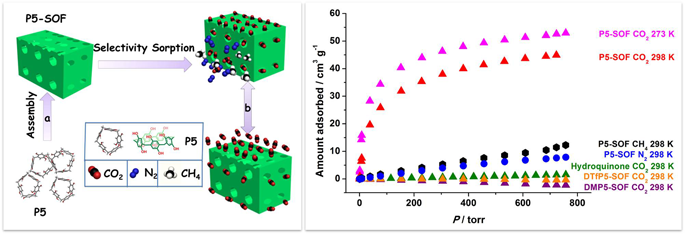Self-assembly of solid-state supramolecular architectures, endowed with nanodimensional pores or cavities, is under intense investigations in recent years owing to their broad applications. As a relatively new class of synthetic macrocyclic host compounds with intrinsic cavity, pillarenes have aroused considerable interest in the community of chemical sciences and materials science. During the past two years, based on the symmetric pillar-shaped architectures, intriguing and peculiar host-guest properties, and highly tunable functionalities of pillarenes and their derivatives, Ying-Wei Yang’s Research Group at Jilin University have successfully shown the catalytic synthesis of pillarene and its derivatives (Org. Biomol. Chem. 2012, 10, 9405-9409), and their applications in molecular recognition (New J. Chem. 2014, 38, 845-851; RSC Adv. 2014, 4, 4330-4333), self-assembled nanostructures (Chem. Commun. 2013, 49, 10528-10530), supramolecular sensors and herbicide detection (J. Am. Chem. Soc. 2013, 135, 1570-1576; RSC Adv. 2013, 3, 5765-5768; RSC Adv. 2013, 3, 22111), controlled drug release (Small 2013, 9, 3224-3229; Chem. Eur. J. 2014, 20, 2998-3004), mechanically interlocked molecules (Chem. Commun. 2014, 50, 6196-6199), fluorescent enhancement materials (Chem. Commun. 2014, 50, 8231–8234; Chem. Commun. 2014, DOI: 10.1039/C4CC03992K), etc.
Recently, they described a new type of pillarene-based low-density solid-state porous supramolecular organic framework (SOF) materials with both honeycomb-like structure, permanent porosity, high thermal stability, extraordinarily selective and reversible sorption properties toward CO2 at ambient conditions by the effective packing of robust, soluble, readily available and functionalized perhydroxyl-pillar[5]arene (P5) compared with most reported SOFs with intrinsic cavity (especially macrocycle-SOF) for the first time. The effective packing of the rigid supramolecular macrocyclic compounds through O-H•••O hydrogen bonds and the control experiments indicated that the high gas uptake is mainly due to the porous nanostructure of the compound and the dipole interactions between CO2 and hydroxyl groups of P5. P5-SOF shows multiple advantages that are crucial for the potential application of porous materials. Their initial results on the high selectivity of CO2 capture (375/1, 339/1 over CH4 and N2 under the standard temperature and pressure) at ambient conditions provide a glimpse into the vast potential of pillarene-based solid-state SOFs in CO2 capture of post-combustion power plants and natural gas sweetening. The work just published in Advanced Materials (Adv. Mater. 2014, DOI: 10.1002/adma.201401672). This result may pave a new avenue to the applications of pillarenes as sensors, catalysts, gas-storage and gas-separation devices, etc.
